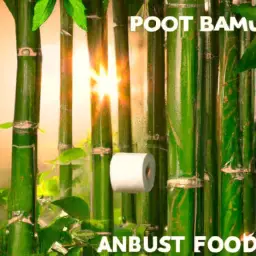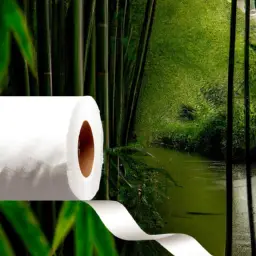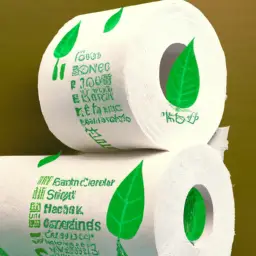I’m thrilled to share the breaking news about a game-changing solution for sustainable toilet paper.
There’s a new innovation that promises to revolutionize the way we think about this essential product.
I can’t wait to dive into the details and explore the benefits of this eco-friendly alternative.
Get ready to discover how we can make a positive impact on the environment with this exciting development.
The Environmental Impact of Traditional Toilet Paper

As a writer, I must address the environmental impact of traditional toilet paper, highlighting its potential harm to the environment.
When we think about reducing waste, toilet paper may not be the first thing that comes to mind. However, the truth is that traditional toilet paper production contributes to deforestation and greenhouse gas emissions. The vast amount of trees cut down to make toilet paper leads to habitat destruction and loss of biodiversity. Furthermore, the manufacturing process involves chemicals and energy-intensive processes that contribute to pollution and carbon emissions.
Fortunately, there are compostable options available that can help reduce the environmental impact of toilet paper. Compostable toilet paper is made from renewable resources like bamboo or recycled paper fibers. These alternatives break down naturally and can be composted, providing a sustainable solution to traditional toilet paper. By choosing compostable toilet paper, we can reduce the amount of waste sent to landfills and minimize the need for tree cutting. Additionally, some companies are even offering toilet paper made from agricultural waste, further reducing the environmental impact.
Exploring Sustainable Alternatives to Conventional Toilet Paper

Before delving into sustainable alternatives to conventional toilet paper, let me first provide some context on the current state of toilet paper production and its impact on the environment.
Toilet paper is an everyday essential that most of us take for granted. However, its production has significant environmental consequences. The production process involves cutting down trees, using large amounts of water and energy, and releasing harmful chemicals into the environment. Additionally, the disposal of toilet paper contributes to deforestation and clogs our sewage systems.
Fortunately, there are sustainable toilet paper alternatives and eco-friendly bathroom products available in the market. These alternatives aim to minimize the negative impact on the environment by using recycled materials, reducing water and energy consumption during production, and employing eco-friendly packaging.
To provide a clearer picture, here is a table showcasing some sustainable toilet paper alternatives and their key features:
| Sustainable Toilet Paper Alternatives | Key Features |
|---|---|
| Recycled Toilet Paper | Made from recycled paper |
| Bamboo Toilet Paper | Made from sustainable bamboo |
| Hemp Toilet Paper | Made from renewable hemp fibers |
Benefits of Bamboo Toilet Paper for the Environment

One of the benefits of bamboo toilet paper for the environment is its sustainable sourcing and production methods. Bamboo is a fast-growing plant that requires minimal water and no pesticides to grow. This means that bamboo can be harvested without depleting natural resources or causing harm to the environment. Additionally, bamboo forests help to reduce carbon dioxide levels in the atmosphere, making bamboo toilet paper a carbon-neutral option.
Another advantage of bamboo toilet paper is its ability to reduce waste. Traditional toilet paper is made from trees, which take many years to grow and require large amounts of water and chemicals during production. In contrast, bamboo can be harvested and regrown within just a few years, making it a more sustainable choice. By using bamboo toilet paper, we can help to conserve precious natural resources and reduce the amount of waste that ends up in landfills.
Furthermore, bamboo toilet paper often comes in eco-friendly packaging. Many brands use recycled or biodegradable materials for their packaging, reducing the environmental impact of the product. By opting for bamboo toilet paper with eco-friendly packaging, we can contribute to a greener future and minimize our carbon footprint.
How Bamboo Toilet Paper Is Made: A Sustainable Process

When it comes to the production of bamboo toilet paper, a sustainable process is followed. Sustainable toilet paper manufacturing begins with the harvesting of bamboo plants, which are known for their fast-growing nature and ability to regenerate quickly. Unlike traditional toilet paper made from trees, bamboo doesn’t require replanting after harvesting, reducing the need for deforestation.
The process starts by cutting the bamboo stalks into small pieces and then boiling them to remove impurities. Next, the bamboo is crushed into a pulp and mixed with water to create a slurry. This slurry is then spread onto a mesh screen, where water is drained, and the remaining pulp is pressed to form thin sheets. These sheets are then dried and rolled into the familiar toilet paper rolls we use.
The environmental benefits of bamboo toilet paper production are numerous. Bamboo grows rapidly, reaching maturity in just a few years, making it an easily renewable resource. Additionally, bamboo requires less water and fewer pesticides than trees, reducing the environmental impact of its cultivation.
Reducing Deforestation With Bamboo Toilet Paper

I’m excited to share that we can make a significant impact on reducing deforestation by switching to bamboo toilet paper. Bamboo toilet paper production offers a sustainable alternative to traditional toilet paper made from trees. Bamboo is a fast-growing grass that can be harvested in just three to five years, compared to the 20 to 50 years it takes for trees to mature. This rapid growth rate makes bamboo an excellent renewable resource.
By using bamboo instead of trees, we can help protect our forests and wildlife habitats. Deforestation is a major contributor to climate change, as trees absorb carbon dioxide and release oxygen. By reducing deforestation, we can mitigate the effects of climate change and preserve biodiversity.
In addition to its environmental benefits, bamboo toilet paper also offers unique advantages. It’s naturally antibacterial and hypoallergenic, making it gentle on the skin. Bamboo fibers are also stronger and more absorbent than traditional toilet paper, meaning you need less of it for each use.
Switching to bamboo toilet paper is a simple yet impactful change we can make in our everyday lives to promote sustainability. By choosing bamboo, we can contribute to the reduction of deforestation and enjoy the numerous benefits it offers.
The Role of Bamboo Plantations in Conservation Efforts

As a sustainable alternative to traditional tree plantations, bamboo plantations play a crucial role in conservation efforts by promoting biodiversity and preserving natural habitats. Bamboo is a fast-growing plant that can be harvested in just a few years, unlike trees that take decades to mature. This rapid growth makes bamboo an ideal choice for sustainable resource management.
One of the key benefits of bamboo plantations is their ability to promote biodiversity. Bamboo forests provide a habitat for a wide range of species, including birds, insects, and mammals. The dense foliage and tall canopies of bamboo provide shelter and food sources for these animals, contributing to the overall biodiversity of the area.
Additionally, bamboo plantations help in preserving natural habitats. By using bamboo as an alternative to traditional tree plantations, we can reduce the pressure on natural forests. This, in turn, helps to protect the habitats of endangered species and preserves the delicate balance of ecosystems.
To highlight the importance of bamboo plantations in conservation efforts, here is a table showcasing some of the key roles they play:
| Role of Bamboo Plantations | Conservation Efforts |
|---|---|
| Promoting biodiversity | Preserving habitats |
| Rapid growth | Reducing deforestation |
| Sustainable resource | Protecting ecosystems |
| management | |
| Habitat for various | |
| species |
Incorporating bamboo plantations into our conservation efforts not only helps in preserving natural habitats but also contributes to sustainable resource management and the overall health of our planet. It is crucial that we recognize and support the role of bamboo plantations in our efforts towards a more sustainable future.
Innovations in Packaging: Eco-Friendly Solutions for Toilet Paper

How can we implement eco-friendly solutions for packaging toilet paper?
One of the key areas where we can make a significant impact is through the use of eco-friendly packaging. Traditional toilet paper packaging often involves the use of plastic, which contributes to waste and pollution. By adopting eco-friendly packaging materials, we can reduce waste and promote sustainability.
One innovative solution for eco-friendly packaging is the use of recycled materials. Instead of using virgin materials for packaging, recycled materials can be used to create packaging that’s both environmentally friendly and functional. This not only reduces the demand for new materials but also helps to divert waste from landfills.
Another approach to eco-friendly packaging is the use of biodegradable materials. These materials are designed to break down naturally over time, reducing their impact on the environment. By using biodegradable packaging for toilet paper, we can ensure that it doesn’t contribute to the growing problem of plastic pollution.
In addition to using eco-friendly materials, reducing waste in packaging is also crucial. This can be achieved through the use of minimalist packaging designs that prioritize functionality and sustainability. By eliminating unnecessary layers or excess packaging, we can reduce waste and promote a more sustainable approach to packaging toilet paper.
Taking Steps Towards a Greener Bathroom Routine With Sustainable Toilet Paper

To achieve a greener bathroom routine, I can start by incorporating sustainable toilet paper into my daily habits. It’s important to consider the environmental impact of the products we use, and opting for eco-friendly toilet paper options is a simple yet impactful way to make a difference.
When it comes to green bathroom products, there are several eco-friendly toilet paper options available. One option is to look for toilet paper made from recycled materials. This helps reduce the demand for virgin wood pulp, which is often used in the production of traditional toilet paper. By choosing recycled toilet paper, I can contribute to the conservation of forests and reduce the carbon footprint associated with the manufacturing process.
Another eco-friendly choice is bamboo toilet paper. Bamboo is a fast-growing and renewable resource that requires less water and land compared to traditional tree pulp. Bamboo toilet paper is also biodegradable and compostable, making it an excellent option for those looking to minimize their environmental impact.
In addition to choosing sustainable toilet paper, I can also consider reducing my overall paper consumption by using less toilet paper per use. Being mindful of my usage and making conscious efforts to minimize waste can further contribute to a greener bathroom routine.
Taking steps towards a greener bathroom routine with sustainable toilet paper is a simple yet effective way to make a positive impact on the environment. By choosing green bathroom products like recycled or bamboo toilet paper, I can contribute to the conservation of natural resources and reduce my carbon footprint. It’s a small change, but every step counts in creating a more sustainable future.
Conclusion
In conclusion, bamboo toilet paper offers an innovative and sustainable solution for reducing the environmental impact of traditional toilet paper.
With its eco-friendly production process and the ability to reduce deforestation, bamboo toilet paper is a step towards a greener bathroom routine.
Additionally, innovations in eco-friendly packaging further contribute to its sustainability.
By choosing sustainable toilet paper options, we can make a positive impact on the environment and create a more sustainable future for all.

